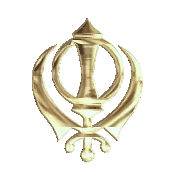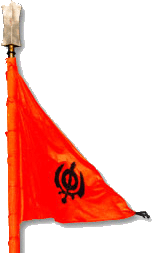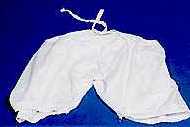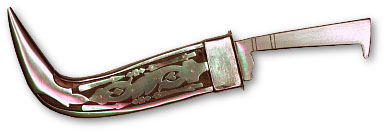Sikh
Symbols

The Sikh
Insignia - Khanda

The Khanda constitutes three symbols in one. However, the
name is derived from the central symbol, Khanda, a special type of
double-edged sword which confirms the Sikhs' belief in One
God.
This consists of four parts (weapons) namely a Khanda, a
Chakkar and two Swords.
KHANDA : This a double edged
dagger with a pointed triangular shaped upper end. This a powerful
weapon used in battle. In spiritual interpratation, it signifies a
powerful means to distinguish truth from falsehood. Khanda was used
by Guru Gobind Singh Ji for preparing Amrit by stirring it in the
sweetened water kept in and iron Bowl (Baata).
* The double-edged sword is the creative power of God which
controls the destiny of the whole creation. It is sovereign power
over life and death.
* The right edge of the double-edged
sword symbolises freedom and authority governed by moral and
spiritual values.
* The left edge of the double-edged sword
symbolises divine justice which chastises and punishes the wicked
oppressors.
SWORDS : Two swords in the outer periphery
signifing two Kirpans of Miri and Piri. This philosphy of Miri and
Piri i.e. Bhakti and Shakti was highlighted by Guru Har Gobind Sahib
Ji - The Sixth Guru. He wore two Kirpans representing Miri and Piri.
* On the left side is the sword of spiritual
sovereignty, Piri; on the right side is the sword of
political sovereignty, Miri.
CHAKKAR :
This is an iron weopon circular in shape
whose outer edges are sharp. Its circular shape signifies God, who
is endless having no begining and no end. This also signifies
struggle for one’s life, liberty and rights. That is why Lord
Krishna used Sudershan Chakkar as a powerful weapon in the war of
Mahabharat.
There must always be a balance between the two and this
balance is emphasised by a inside circle. The circle is what is
called the Chakra. This is a symbol of all-embracing divine
manifestation including everything and wanting nothing, without
beginning or end, neither first or last, timeless, and absolute. It
is the symbol of oneness, unity, justice, humanity and morality. The
Chakra was also used by the Sikhs as one of the war weapons against
injustice and oppression. Almost all Sikh warriors used to wear it
in the eighteenth century.
The Sikh Flag - Nishan
Sahib

The Sikh flag is a saffron-coloured triangular-shaped cloth,
usually reinforced in the middle with Sikh insignia in blue. It is usually
mounted on a long steel pole (which is also covered with saffron-coloured
cloth) headed with a Khanda. The Sikh flag is often seen near the entrance
to the Gurdwara, standing firmly on the platform, overlooking the whole
building. Sikhs show great respect to their flag as it is, indeed, the
symbol of the freedom of the Khalsa.
Nishan Sahib is a triangular
shaped Kesri (Dark Yellow or blue) coloured cloth with or inscribed on it
in the middle hoisted on a pole below a steel Khanda.
It is said
words "Waheguru Ji Ki Fateh" in Punjabi script (Victory of God) was
inscribed on the Nishan Sahib of Guru Gobind Singh Ji. During Maharaja
Ranjit Singh’s times words "Akal Sahai" in Punjabi script were unscribed
on the Nishan Sahib. During times Sikh Misals, "Nishan Walia" Misal used
to provide Sikhs for carrying Nishan Sahib to all the Misals during
battles. Nishan Sahib on Pole of suitable height is hoisted on all
Gurdwaras. This indicates the location of the Gurdwara.
Once,
Nishan Sahib bearer named Bhai Alam Singh fell in the hands of Mughal
enemy forces during a battle. He was told to throw the flag or else, his
hand would be chopped off. Bhai Alam Singh replied that in that case he
would keep holding the flag with his feet. Then he was told that if his
feet would also be cut off.
Bhai Alam Singh replied that in such
eventuality he would hold it with his mouth. "In case, his head is also
cut, then what he will do?" he was asked. Bhai Alam Singh replied with
confidence, "The Guru whose flag he was carrying well take care of it."
This is the as how the Nishan Sahib was held in great esteem by the Sikhs
in those days
The Five
K's
The five sacred
Sikh symbols prescribed by Guru Gobind Singh are commonly known as
Panj Kakars or the 'Five Ks' because they start with letter K
representing Kakka in the Punjabi language. They are:
1. Kes or unshorn
hair, regarded as a symbol of saintliness. Guru Nanak started the
practice of keeping the hair unshorn. The keeping of hair in its
natural state is regarded as living in harmony with the will of God,
and is a symbol of the Khalsa brotherhood and the Sikh faith. Hair
is an integral part of the human body created by God and Sikhism
call for its preservation. The shaving or cutting of hair is one of
the four taboos or Kurehats.
Long unshorn hair. A symbol of
spirituality. The Kesh reminds a Khalsa to behave like the Guru's.
It is a mark of dedication and group consciousness, showing a
Khalsa's acceptance of God's will. Long hair have long been a common
element of many spiritual prophets of various religions such as
Jesus, Moses and Buddha
2. Kangha or the comb is
necessary to keep the hair clean and tidy. A Sikh must comb his hair
twice a day and tie his turban neatly. The Gurus wore turbans and
commanded the Sikhs to wear turbans for the protection of the hair,
and promotion of social identity and cohesion. It has thus become an
essential part of the Sikh dress. A symbol of hygiene and
discipline as opposed to the matted unkept hair of ascetics. A
Khalsa is expected to regularly wash and comb their hair as a matter
of self discipline.

3. Kara or the steel
bracelet symbolises restrain from evil deeds. It is worn on the
right wrist and reminds the Sikh of the vows taken by him, that is,
he is a servant of the Guru and should not do anything which may
bring shame or disgrace. When he looks at the Kara, he is made to
think twice before doing anything evil with his hands.

4.
Kachh or the soldiers
shorts must be worn at all times. It reminds the Sikh of the need
for self-restrain over passions and desires. Apart from its moral
significance, it ensures briskness during action and freedom of
movement at all times. It is a smart dress as compared to the loose
dhoti which most Indian wore at that time A symbol signifying self
control and chastity

5.
Kirpan or the sword is
the emblem of courage and self-defence. It symbolises dignity and
self-reliance, the capacity and readiness to always defend the weak
and the oppressed. It helps sustain one's martial spirit and the
determination to sacrifice oneself in order to defend truth,
oppression and Sikh moral values. A symbol of dignity and the Sikh
struggle against injustice. It is worn purely as a religious symbol
and not as a weapon. When all other means of self protection fail,
the Kirpan can be used to protect yourself or others against the
enemy.

Sword in Sikhism
Very many
people question the need of Kirpan or the sword in the atomic age.
Others require an explanation for the wearing of the sword. How can
sword he reconciled with spirituality ? Even before Guru Gobind
Singh Sahib, his grand father Guru Hardgobind had donned the sword
as a twin-symbol of temporal and spiritual power(Miri & Piri).
He had maintained an army and taken part in military operations
against the Mughal forces.
Guru Gobind Singh Sahib justified
the use of the sword as a duty and as a means of protecting the weak
and the oppressed. With human brutes, non-violence is meaningless.
Guru Gobind Singh Sahib says:
When the affairs are past
other remedies,
It is justifiable to unsheath the sword.
Tyrants are like mad dogs and wolves. They should be
opposed in the interests of the good of humanity as a whole. The
sword is neither to be used for conquest nor for wreaking vengeance.
The sword is meant only for self-defence or for the good of the
people. In cases of injustice and intolerance, the refusal to use
the sword may do more harm than good. The Sikh's sword is not an
instrument of offence but a symbol of independence, self-respect and
power. Guru Gobind Singh Sahib called it Durga or Bhagwati and
praises it thus :
Sword that smites in a flash,
That
scatters the armies of the wicked
In the great battle-field,
0 symbol of the brave.
Your arm is irresistible, your
brightness shines forth
The splendour of the black dazzles like
the sun.
Sword, you are the scourge of saints,
You are the
scourge of the wicked ;
Scatterer of sinners, I take refuge with
you.
Hail to the Creator. Saviour and sustainer,
Hail to you
: Sword supreme !
The Five
K's, along with the turban, constitute the Khalsa uniform, which
distinguishes a Sikh from any other person in the world, and is
essential for preserving the life of the community and fostering the
Khalsa brotherhood.
The Five K's are not supposed to foster
exclusiveness or superiority. They are meant to keep the Sikhs
united in the pursuit of the aims and ideals of the Gurus. They
enable them to keep their vows made at the time of baptism. The
Sikhs have been known to face torture and death rather than cut
their hair or remove any of the sacred symbols.
The
Khalsa cannot be anonymous. His religion is known to all. He stands
out among people, and any unseemly behaviour or action on his part
would be noted as unbecoming of a follower of the Gurus. People
would easily blame him if he deviated from the disciplinary code of
Guru Gobind Singh.
Gateway to
Sikhism. Copyright © 2001 . All rights reserved.

